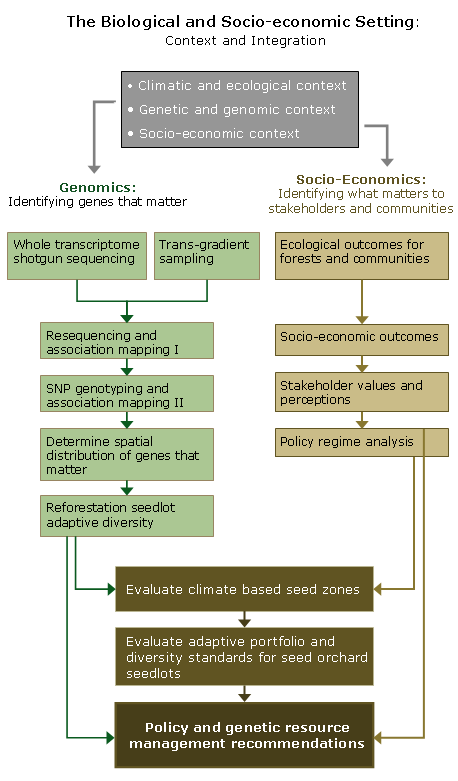Scientific Summary
A changing climate is the largest threat to forest productivity in western Canada and to the ability of forested landscapes to provide ecological, economic, and cultural services, both now and in the future. We propose applying state-of-the-art technologies and analytical methods from genomics, geospatial analysis, and climate modelling to the two most economically important western Canadian tree species – lodgepole pine (Pinus contorta) and interior spruce (Picea glauca, P. engelmannii, and their hybrids). Coupled with in-depth socially-based inquiry into the potential socio-economic impacts on forest-dependent communities, this research will provide crucial information to guide reforestation policies and practices for uncertain future climates. As climate changes and genotypes become increasingly mismatched with local conditions, the production of some 45 million m3 of timber for annual harvest in British Columbia and Alberta from these two species – worth well in excess of $10 billion per year – is predicted to diminish up to 35% this century. This problem can be reduced dramatically with interventions that match reforestation stock to anticipated future environments. However, there is a pressing need to inform such actions by carefully developing and contextualizing scientific information and by applying it through appropriate provincial reforestation policies. Reforestation seedlots from seed orchards that are selectively bred for increased growth rates and wood quality under current climatic conditions are the genetic and economic basis of tomorrow’s harvests. These select genotypes need to be spatially reallocated to climatically suitable habitat over vast areas through operational tree planting.
To address this problem, we need to understand which genes are involved in adaptation to local climatic conditions. We will first sequence the transcriptomes of seedlings of both species grown under a range of temperature and moisture treatments to capture the sequences of genes potentially involved in adaptation to climate. We will then determine the genetic architecture of adaptation to climate for temperature- and moisture-related traits through targeted re-sequencing of 10,000 genes in an initial association test of ~750 individuals of each species sampled from a wide geographic area. SNP genotyping and controlled climate association experiments with an additional 4,000 seedlings of each species will then be used to assess the genetic diversity and adaptive capacity of both natural populations and orchard seedlots. Within the three-year timeframe, we will develop strategic climate-based seed zones and policies to manage this adaptive portfolio for uncertain future climates.
This research raises a number of economic, social and value-based questions that we will endeavour to answer by engaging with a range of stakeholders and end-users, including forest-dependent communities, industry representatives and provincial staff responsible for reforestation and seed transfer policy. Based on a series of predictive ecological models that incorporate various intervention strategies and predictions of climate change, we will conduct an assessment of the socio-economic outcomes and explore both the understanding and perceptions of this range of plausible climate change adaptation strategies for BC and Alberta. With a better understanding of the role of genetic resources in the ecological, economic and social sustainability of forests and the communities that depend on them, we will – through a thorough policy regime analysis – translate our technical findings into substantive changes in policy and forest management that address climate change in a proactive and strategic manner. Our project will provide the scientific basis and policy recommendations with which to insure the productivity of our forests of tomorrow and avoid losses of up to hundreds of millions of harvest and wood product value per year over the next century.

For a more general introduction to the AdapTree project visit our “For the Public” webpage.
